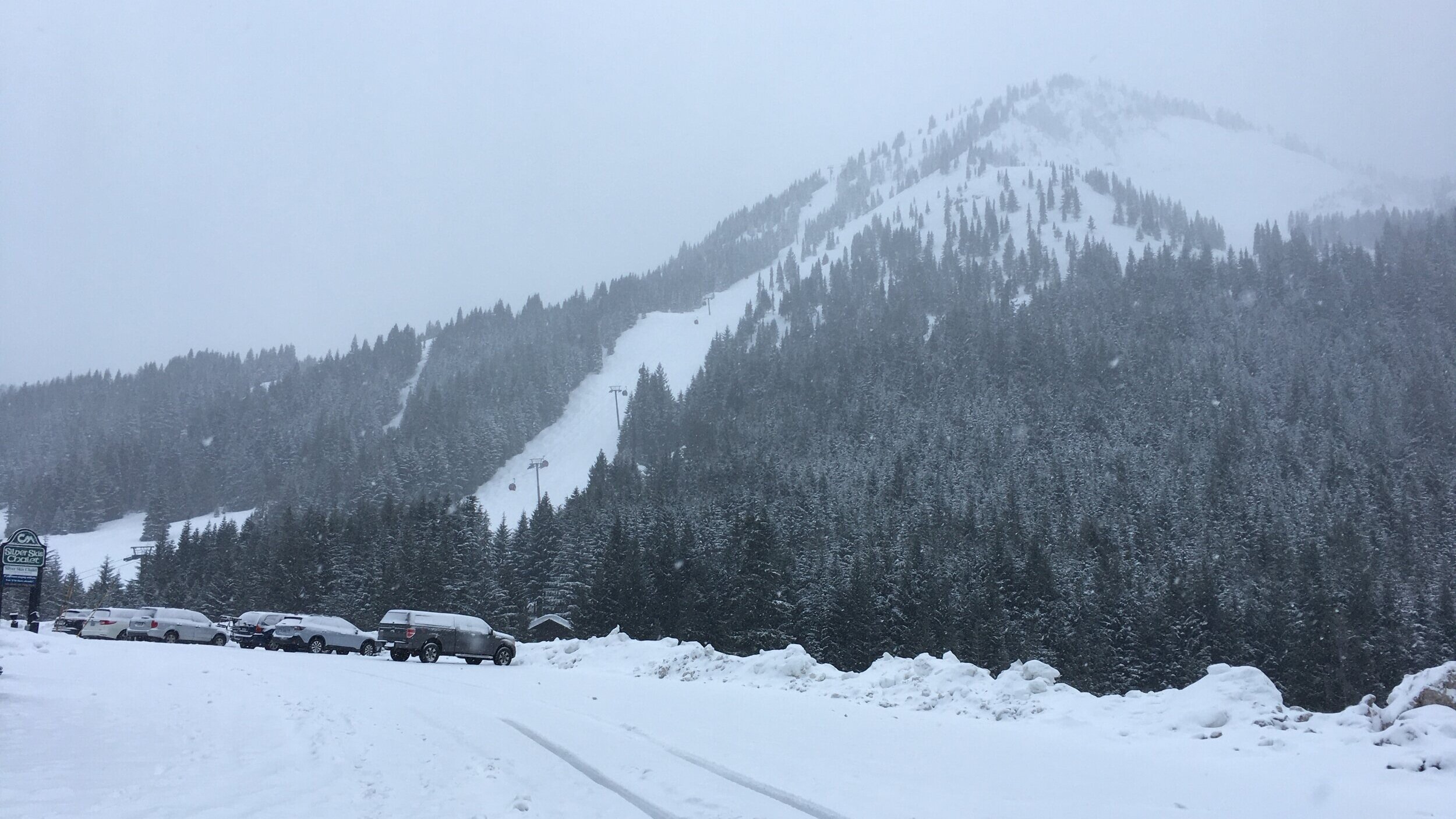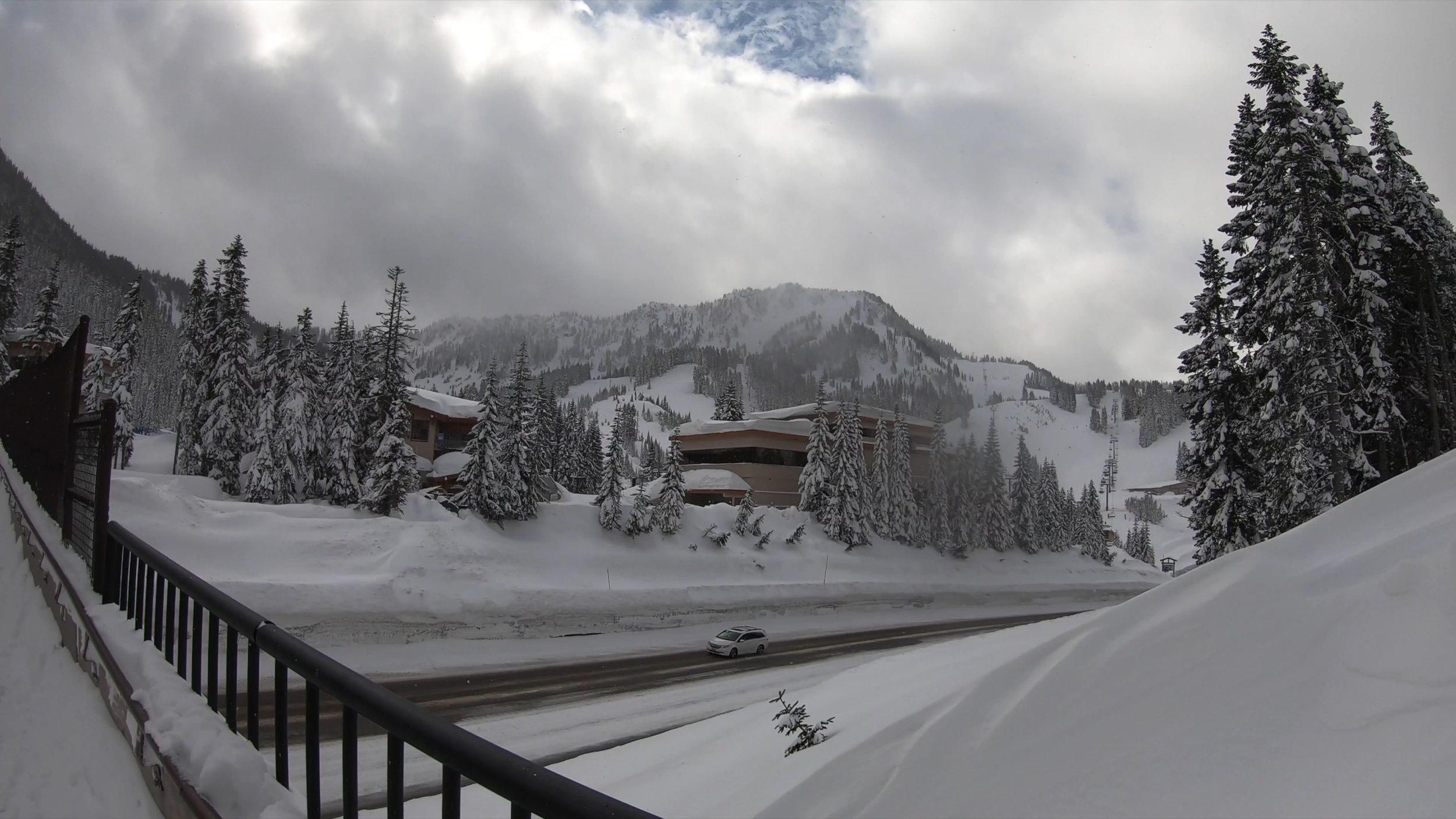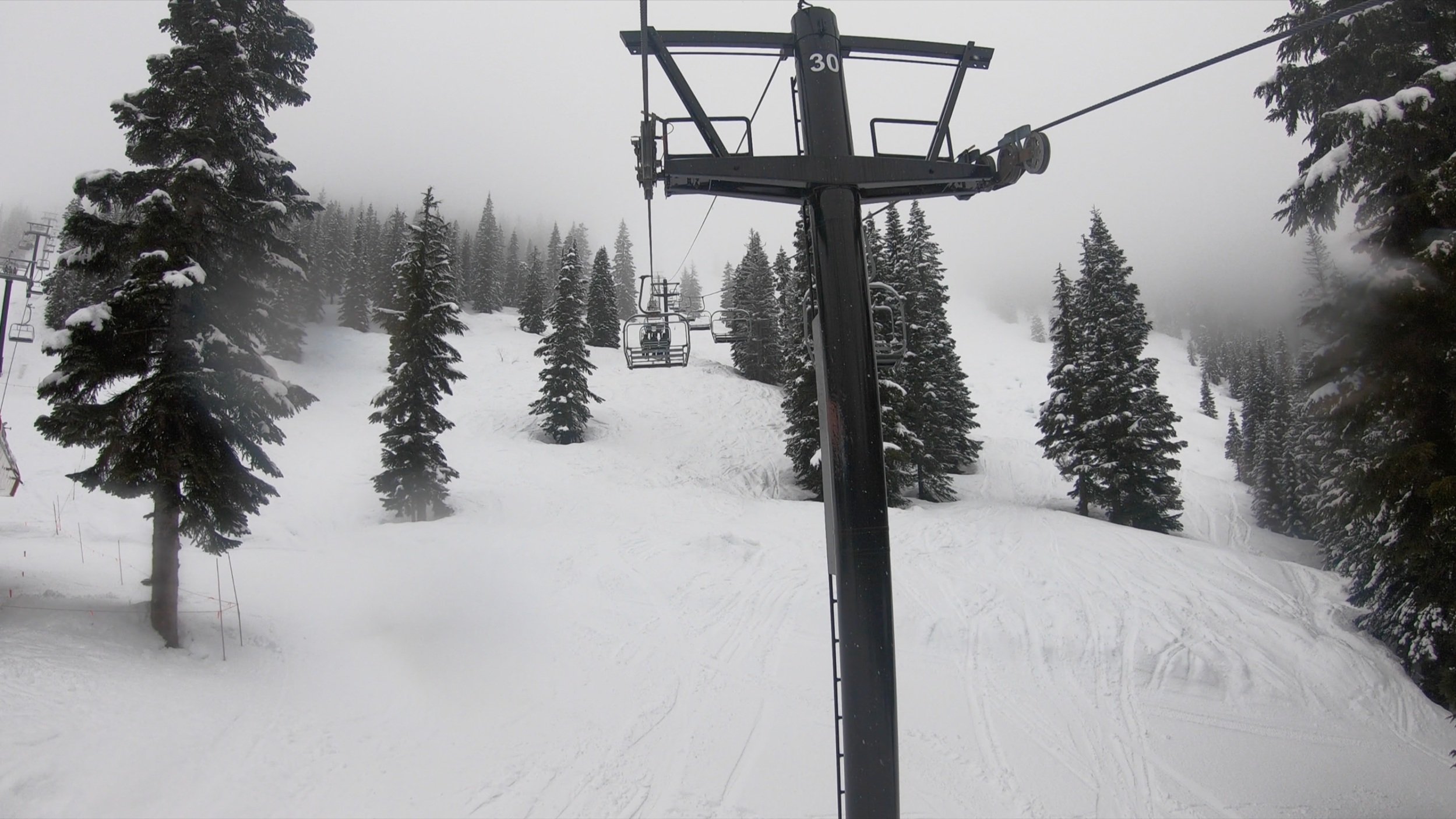Why Washington and Oregon Have No Real Destination Ski Resorts
When it comes to the US states of Washington and Oregon, both states feature sizable skiing presences. Not only do these states have multiple ski resorts across various in-state regions, but their mountains also span an extensive range of shapes, sizes and terrain types.
However, when it comes to booking a fly-to destination ski vacation, the vast majority of folks overlook both these states—and instead opt to go to mountains across various other parts of Western North America. In fact, one could argue that Washington and Oregon are the only two states or provinces in or surrounding the northwestern part of the United States that don’t host at least one destination ski resort.
So this begs the question—why is nobody seriously traveling to ski or ride here? And has everyone been getting it wrong this whole time? Let’s take a look.
Cities such as Seattle and Portland are within day trip distance of Washington and Oregon’s ski resorts.
Reason #1: Nearby Population Centers
The first thing we need to discuss surrounding the Washington and Oregon ski resorts are the nearby population centers. The overwhelming majority of these mountains are close to large cities, with four major Washington ski areas within two hours of Seattle, and three major Oregon ski areas within two hours of Portland. Combined, these cities have a metropolitan area population of over 6 million people. This means there’s already a massive visitor pool for these mountains based on nearby residents alone, and they don’t need to attract visitors from out of state to get business.
Crowding and Multi-Resort Pass Access
But the demand in these regions takes the situation even further. It’s not just that these resorts don’t need destination visitors, it’s that there’s so much visitation from locals that there isn’t even room for outside vacationers. In fact, access road traffic and on-mountain crowds have been so unsustainable at some of these mountains that they’ve chosen to implement reservations, some paid, or even turn people away after certain hours.
Most of these resorts are on some sort of megapass, with Crystal, Summit at Snoqualmie, and Alpental on the Ikon Pass, Stevens Pass on the Epic Pass, and a few resorts on more under-the-radar products such as the Indy Pass. But these pass issuers haven’t exactly been going out of their way to market these mountains—and their capacity issues. In the case of Crystal, the resort cut Ikon access back from unlimited to five or seven-day access to control the number of locals who visit—and replaced unlimited access with a standalone wallet-draining $1,900 season pass.
Thanks in part to their proximity to large cities, Washington and Oregon’s most prominent ski resorts see a ton of local traffic on weekends and holidays.
Night Skiing Operations
Another factor that reflects the region’s commuter-oriented nature: widespread night skiing. Unlike most Rockies destination resorts, every ski resort within reasonable commuting distance of Seattle and Portland hosts some flavor of lift-served twilight or evening operations. Mount Hood Skibowl and Summit at Snoqualmie, in particular, are known for making night skiing a central part of their offerings.
A Note on Mount Bachelor
Oregon’s Mount Bachelor might be the notable exception to this major metro area rule and the associated impacts (a couple of other ski resorts in these states also sit in less populous areas, but they’re on a smaller side). The nearest town is Bend, which is only about a tenth of the size of Portland.
However, Bend has also grown a ton in recent years and now is substantially bigger than most typical ski towns. As a result, while still manageable, on-site crowds have definitely increased at Mount Bachelor as well.
From the East Coast, Washington and Oregon take a lot longer to fly to than popular Rockies destinations—and they don’t have a standout “wow” factor to encourage people to make the extra trek.
Background map via MapTiler and OpenStreetMap
Reason #2: Physical Geographic Location
Let’s say you want to visit these resorts on an off-peak weekday, when they’re at least relatively empty. The crowds won’t be an issue anymore, so what now?
Well when it comes to terrain, some of Washington and Oregon’s resorts do offer slope setups that look competitive with other destinations on paper. The best resorts, including Crystal, Mount Bachelor, and Mount Hood Meadows, feature sizable footprints that take multiple days to cover, with diverse terrain ranging from bowls, to trees, to treacherous challenges.
However, for many fly-to vacation-goers, the Pacific Northwest mountains take a lot longer to travel to than competing mountains in Colorado and Utah—and while their terrain is definitely enjoyable, for most travelers, the experiences won’t stand out enough to justify the extra flight time.
Comparison with Other West Coast Ski Regions
In terms of distance, it’s easy to compare these states with places like Whistler Blackcomb and the Lake Tahoe region, which are just as tough—or even tougher—to get to than Washington and Oregon’s resorts. However, both of those destinations offer truly extraordinary features, such as a world-class footprint size in the case of Whistler and one-of-a-kind lake views in the case of Tahoe, that present something starkly different than the slopes of the Rockies—and as a result, might encourage typical vacationers to go out of their way to ski or ride there.
For most out-of-towners, Washington and Oregon’s best resorts just don’t have that same “wow” factor to justify the extra travel time from eastern parts of North America.
At Washington and Oregon’s ski resorts, the ski towns typically look like…this.
Reason #3: Lack of Ski Towns
Another factor that significantly detracts from the destination appeal in these states, perhaps even moreso than the terrain itself, is their substantial on-site lodging and activity deficit. For many destination vacationers, the inability to stay in a slopeside ski town will essentially be a dealbreaker.
Limited On-Site Lodging
Both states have exactly one large resort with true ski-in/ski-out accommodations: Timberline Lodge in Oregon, and Crystal in Washington. The accommodations at both resorts have a ton of character—and in the case of Timberline, the sole hotel is designated as a National Historic Landmark—but capacity is extremely limited, and spots fill up quickly.
Summit at Snoqualmie and Mount Hood Skibowl do offer accommodations that sit a short walk or drive from the slopes, but they’re primarily bargain basement and not designed to attract people for high-class hotel experiences. However, these options still end up being quite expensive due to the low supply.
Lack of Nearby Off-Site Accommodations
Okay, so if you can’t stay directly on-site, is there anything at least nearby? After all, some folks may not mind a short drive to reach the mountains, even if it’s mildly inconvenient.
Unfortunately, options in close proximity to most of Washington and Oregon’s large resorts tend to be nearly as limited as those directly on the slopes. With the exception of the hotels and inns we already mentioned, the nearest practical lodging options require a considerable drive, with reasonable accommodations living as far as 45 minutes away for the most remote resorts.
Underwhelming Post-Slopes Activities
In addition to the lack of lodging, none of Washington and Oregon’s ski resorts come with any sort of true slopeside mountain town, so there aren’t really many activities going on around the slopes either. In fact, if you want to do anything after your day skiing or riding, such as checking out an off-premise restaurant, town, or bar, it’ll take a drive that’s just as lengthy as reaching the nearest accommodations. And unless you’re in Bend, which is actually a really cool town, you’ll pretty much be in the Seattle, Portland, or Bellingham suburbs by the point you reach these activities.
Despite their proximity to Seattle and Portland, the access roads to Washington and Oregon’s ski resorts can get really dangerous to drive on—and the lack of on-site lodging means most guests will have to make use of them twice a day.
Reason #4: Mountain Access Difficulties
Even though most of Washington and Oregon’s relevant mountains are within only an hour or two of Seattle or Portland, once the terrain turns mountainous, both of these states get really remote really quickly.
The drives to and from these mountains are far from straightforward. Due to mountainous terrain, rapid freeze-thaw changes, and variable visibility, the conditions on access roads to all of these resorts can be extremely sketchy. As a result, driving to these mountains is not fun, and public transportation options can be limited—making it really difficult to plan a multi-day trip to most of these mountains. In fact, Stevens Pass’s bus service stopped operating last year due to the road conditions, and if you don’t want to drive there, you now have to carpool. Not exactly relaxing for a destination vacation!
Most of Washington and Oregon’s ski resorts sit on or adjacent to National Forest Land (shaded in dark green) or National Parks (shaded in light green). This makes it really hard to expand on resort options.
Reason #5: Limited Expansion Opportunities
So you might be thinking—everything we’ve covered so far is a solvable problem with capital investments. Why don’t Washington and Oregon just build more ski resorts to address the demand? Or at least expand the ones they have to make them more competitive? And maybe add some on-site lodging while they’re at it too?
Well, it turns out that both states have their hands somewhat tied.
Washington State Circumstances
Specifically in Washington, developable ski resort terrain is close to maxed out due to National Park destinations for large swaths of alpine land. There are far fewer National Parks in Oregon, but most of its development land also falls subject to federal wilderness protections.
In fact, the National Park designation takes some of the craziest potential skiable terrain out of the picture in the state of Washington. Both Rainier National Park and North Cascades National Park have plenty of terrain that could hypothetically make for spectacular in-bounds skiing and riding, but, while for good reason, they’re off limits to any sort of development.
When you visit Washington State, it becomes apparent that the resorts tried to make the most of the land they could before they encroached into National Park territory. Mount Baker is just outside the bounds of the North Cascades National Park, while Crystal is a short distance east from the Rainier National Park, and Mount Rainier itself.
Oregon Circumstances
In the case of Oregon, the state is unique in that the vast majority of its truly prominent mountains are volcanoes. In fact, all of Oregon’s current major ski resorts are either on a volcano or immediately adjacent to one. However, while there are several volcanoes that don’t currently have any ski resorts, including the Three Sisters and Mount Jefferson, a large portion of this land is Protected Wilderness, making those sites just as off-limits to development as the parks in Washington.
Washington and Oregon’s ski resorts often see wet snow and low visibility, making for less-than-enjoyable resort experiences.
Reason #6: On-Mountain Weather Conditions
Okay, but what if we set the land restrictions aside for a second—and consider Washington and Oregon for their land alone? Well, it turns out that there’s one final circumstance that really hurts these states for resort development—and it's the climate conditions.
Part of going on a ski trip involves cold weather, but in return, guests will often find iconic, serene atmospheres. Washington and Oregon’s slopes aren’t as cold as many competitors, but a number of factors can make the resorts really uncomfortable.
Snow Consistency
On the surface, things actually look pretty good conditions-wise, especially when it comes to snow accumulation. In fact, snow totals at the best resorts are much higher than those at most Utah and all Colorado mountains, and Mount Baker, which sits in the most favorable snow line of the state, often receives the highest snow totals of any ski resort on the continent. However, there is a huge catch to this accumulation: snowfall tends to be wet and heavy—and frankly unpleasant to plow through in certain conditions. The snow sticks on outerwear, and visitors will often find themselves soaked after extensive time out in the mountains.
Overcast Skies
Another crucial factor for a top-notch destination ski vacation is the presence of beautiful alpine views. And while the resorts in these states fit the bill when they’re clear, slopes are perennially overcast during the core winter months, making for less than picturesque experiences. Fog poses a significant challenge at all Washington ski resorts, and it’s often impossible to see more than a few feet in front of you, making for scary conditions. And from a practical standpoint, it can be really annoying to keep your goggles unfogged in these moist conditions.
All these resorts occasionally get rain, and combined with the deep, heavy snow, these factors result in some wonky, unpredictable conditions that may come across as unpleasant surprises to those who visit.
Variable Terrain Openings in Oregon
Oregon’s ski resorts tend to experience a bit drier and less fog-prone conditions than those in Washington. But the volcanoes that host these ski resorts drive local weather patterns that result in intense weather events and tremendously variable conditions. As a result, throughout most of the winter season, Oregon's ski resorts face significant operational challenges. Most of the state’s expert and above-treeline areas either rarely open or remain entirely closed during a typical weeklong visit. This means that even if conditions are clear, visitors expecting to explore the destination-grade footprints advertised on resort trail maps will likely end up disappointed.
Final Thoughts
So while some of Washington and Oregon’s ski resorts may seem like great destinations on paper, the states just have factor after factor working against them to allow for destination ski resort development. National park and forest restrictions, wet, difficult weather, and overcapacity from the local population just hurt the case for any of the resorts in these states to become true fly-to destinations.
We will also caveat that Mount Bachelor, the biggest resort in this region, does not fall victim to many of the worst issues that plague some of its neighbors, including horrible traffic, sketchy access roads, and small footprints, that make them really undesirable for weeklong vacations. But it’s still just too far away from the nearest lodging options to drive appeal from typical destination crowds.
But just because Washington and Oregon don’t have any traditional destinations, does that mean you shouldn’t visit them? Absolutely not! Both states have incredible qualities that make them worth checking out for adventurous, commuter-ready powderhounds who want to check out some of the most extreme, snow-laden slopes on the continent—and have the glutes and stamina to power through the wet, heavy snowfall. The resorts also get a lot drier and clearer during the spring, so if you’re looking for some corn skiing in April or May, it might not only be a great trip option, but be the best time to visit these states from other regions.
For more information on skiing and snowboarding in the states of Washington and Oregon, check out our comprehensive ski resort rankings for Washington, Oregon, and the Pacific Northwest. If you’re interested in seeing how they compare to other similar mountains, check out our West Coast and overall rankings.
NOTE: The North America map used for this article was sourced from SANtosito on Wikimedia Commons, and edited with graphics on top of original work.







